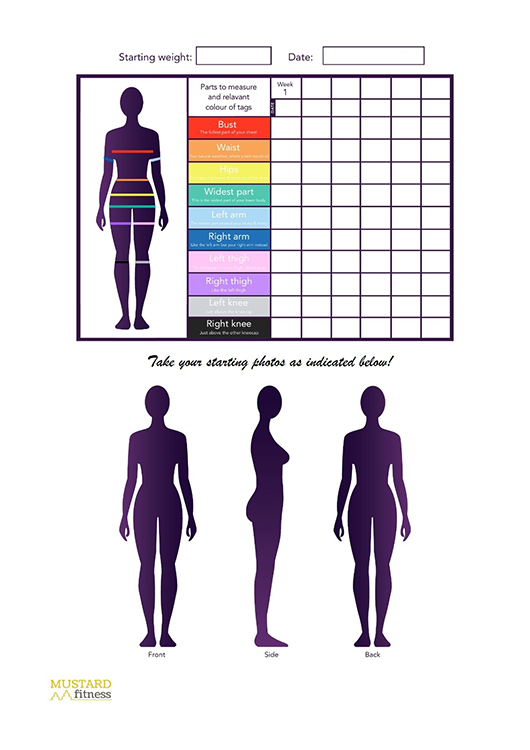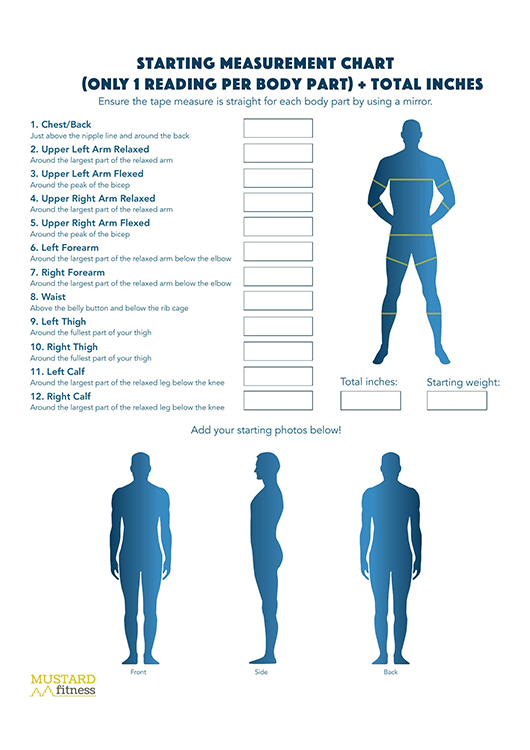![]()
Effective Progress Tracking
Have you ever tried to watch the movement of the hour hand on an analog clock? As patient as you remain, as hard as you focus, it’s pretty difficult to see any shift.
However, looking back after thirty minutes, you’ll see that the hour hand is certainly completing its journey on that slow eternal loop.
Just because you can’t see something moving, it doesn’t mean that it’s stationary.
The same applies to changes in your body.
The majority of us look at ourselves several times a day in the mirror. Which cannot only keep us looking as fresh as a summer cucumber, but can also make us feel that despite all of our hard work with nutrition and exercise, things just don’t seem to change.
This can lead to demotivation and the want to give up on health and fitness entirely.
After all, what’s the point of all that sweat and doughnut dodging if the results aren’t paying off?
But even if daily change isn’t recognizable, things may still be moving in the right direction. Just like that hour hand; slowly making its way.
Which is why effective progress tracking may be the key to unlocking a new kind of motivation.
It not only falls down to identifying where you’re improving and where you’re not, but it can also highlight new areas of focus. Giving you further insights into ways of constructively reaching your goals, faster.
Last month, we explored the most effective ways to begin your first training plan, (check it out right here!), it would only be appropriate for us to follow up with the ideal methods of measuring how far you’ve come on that health and fitness journey.
Whether your goals are to lose body fat, increase your overall fitness level, or gain lean muscle mass; in this article, we’ll cover how to track progress for each and all of the above.
But before we get started, keep in mind that the following methods of progress-tracking have been assigned to their appropriate goal-oriented categories. However, feel free to use a combination of all these methods, regardless of your goals, as further ways of tracking your wins.
Effective Progress Tracking for Fat Loss
If fat loss is your primary goal, you may feel the best, or only approach, to track progress is by stepping on the scale. And although the scale is a very good indicator of weight loss, it’s not ideal for tracking fat loss.
Monthly cycles and hormonal changes, stored water weight, overall hydration levels, bowel movements, muscle gain, workout timings, and even the meals you ate in the last week can all cause the scale to temporarily shift in a surprising direction.
Just because you weigh the same as last week, it doesn’t necessarily mean your body holds the same composition of fat and muscle.
By all means use the weighing scale as a general indicator of progress, but do so with a pinch of salt.
Instead, use body measurements as a more accurate indicator of progress.
Using a non-elastic tape measure, take note of the thickest circumference of your calves, thighs, hips, waist, chest, and upper arms. Or follow the chart we’ve included!
Then, recheck and compare these numbers every three to four weeks to indicate where your progress is being made.
You may be surprised to find that the scale and the measurements aren’t completely in sync.
Along with your scale weight and regular body measurements, progress photos are an excellent way of visually displaying your results.
This can be done very easily, at home, right after waking up. Simply wear some tight-fitting clothes or a swimsuit, place your phone upright, on a flat surface that’s just below the level of your chest. Set a camera timer for ten seconds, and stand about eight to ten feet away.
Say cheese!
Repeat these parameters once a month to watch the results appear right before your own eyes.
Additionally, there’s an excellent form of progress tracking that requires nothing on your part. We like to call them ‘Non-Scale Victories’ and they can include better/looser fitting clothes, compliments from friends and family, and the general feeling of being leaner and lighter when going about your day.
Celebrate these small wins as frequently as possible!
Effective Progress Tracking for General Fitness Levels
If your overall fitness and endurance levels are what you’re aiming to improve the most, we have some effective ways of tracking your progress here too.
Begin with a resting heart rate test. Do this by taking your heart rate first thing in the morning upon waking up.
This is done by holding the tips of your index finger and middle finger gently against the side of your neck, just under your jawline. You should be able to find your pulse. Another method is to place your right palm facing up in front of you. Then place the index and middle fingers of your left hand over your right wrist. Your fingertips should locate your pulse easily.
Count the number of beats for fifteen seconds. Then, multiply that number by four; that is your resting heart rate.
Now it’s time to perform the step test, which can be done at any time in the day.
Using a twelve-inch step, alternate your feet by stepping up and back down continuously for three minutes. The rhythm should be regular and easy, there’s no need to rush. Aim for roughly 24 completed steps per minute.
Once complete, retake your heart rate using one of the same methods mentioned before.
Over time, with appropriate fitness training, both of these numbers should gradually decrease!
If you’d like a more intermediate method of testing your overall cardiovascular fitness, complete a fifteen-minute distance test. Using your favorite method of cardio, whether it be walking, jogging, cycling, rowing, or swimming, perform it for fifteen minutes at your own comfortable pace.
Log the total distance you’re able to cover in that time and retake this test multiple times in the future. Be sure to push yourself a little more with each retest. By following the right cardio regimes between each test, you’ll leave yourself shocked at your progress.
Effective Progress Tracking for Strength and Muscle Gain
Finally, if increasing muscle gain and strength are your number-one priorities, many of the same methods for tracking progress for fat loss can also be applied. Recording your body weight, body measurements and progress photos all work very well. But those ‘Non-Scale Victories’ will also be ever present on your muscle-gaining journey.
But some additional strength and endurance tests can also be taken to track progress here.
The three-minute push-up and three-minute squat tests will give you an excellent indication of your current upper and lower body endurance.
And they’re both very easy to do!
Begin by lightly warming with some slow star jumps or a fast-paced walk. Then start a timer and perform as many push-ups as possible in three minutes. They can be modified/knee push-ups and there’s no need to push yourself too hard; just work at a comfortable rate, resting whenever you feel necessary.
Then, take a five-minute break before performing the same routine but with bodyweight squats. You’ll now have your three-minute push-up and squat endurance numbers to compare and compete with in the future!
Keep in mind, these three-minute tests aren’t limited to only push-ups and squats! Feel free to perform the same tests for any exercise you’d like to track and improve. Planks, pull-ups, burpees, star jumps, and lunges are all exercises that can be tracked using the same method.
Finally, and perhaps a more intermediate or advanced method for tracking strength progress is by using one-rep max tests. One rep max tests (ORMs) are extremely effective ways of testing your current strength levels for various compound motions. These can be performed with great safety and care by using dumbbells, barbells, or gym machinery for various strength lifts.
Recording your maximal output with an amount of resistance and then aiming to increase these amounts by following a rigid training plan is an excellent way to build overall muscle mass and strength.
However, these should be monitored with close vigilance by a professional if attempting for the first time.
To conclude!
Whether your goal is fat loss, improving overall fitness levels, or muscle gain; effective progress tracking is your key to seeing the hour hand move on that analog clock.
Remember, progress is not always immediately visible, but with consistent effort and the right tracking tools, you’ll be able to see the remarkable changes you can make over time.
Embrace these techniques to keep your motivation alive, to refine your strategies, and most importantly, to celebrate every step forward on your journey towards a healthier, fitter, stronger you.


